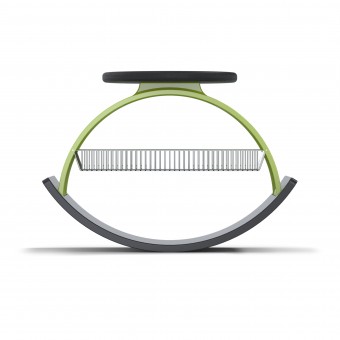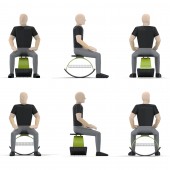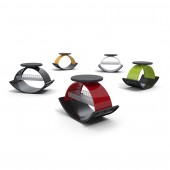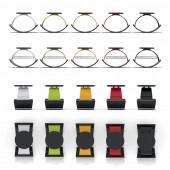
| THE AWARD |
| CATEGORIES |
| REGISTRATION |
| SUBMIT YOUR WORK |
| ENTRY INSTRUCTIONS |
| TERMS & CONDITIONS |
| PUBLICATIONS |
| DATES & FEES |
| METHODOLOGY |
| CONTACT |
| WINNERS |
| PRESS ROOM |
| GET INVOLVED |
| DESIGN PRIZE |
| DESIGN STORE |
| THE AWARD | JURY | CATEGORIES | REGISTRATION | PRESS | WINNERS | PUBLICATIONS | ENTRY INSTRUCTIONS |
Span Rocking Stool by Jeffrey Koffman |
Home > Winners > Design #28155 >Interview |
 |
|
FS: What is the main principle, idea and inspiration behind your design?
JK: The concept was driven by the need for small modular seating elements in the workplace. The idea of "fun" became a primary focus and therefore the principles of a rocking horse were incorporated into the design. Adding a storage component for phones, tablets and personal items helped create value and add utility to the rocker.
FS: What has been your main focus in designing this work? Especially what did you want to achieve?
JK: The primary focus is aimed at creating fun, interactive, modular seating elements for impromptu collaborative meetings.
FS: What are your future plans for this award winning design?
JK: I hope to find a licensee to develop and distribute this product concept.
FS: How long did it take you to design this particular concept?
JK: From research thru design, modeling and rendering it took approximately 2 1/2 months.
FS: Why did you design this particular concept? Was this design commissioned or did you decide to pursuit an inspiration?
JK: When there are unmet needs designers try and find solutions to address these specific areas. Span was developed as an answer to the problems of seating and collaborative teaming in the work place.
FS: Is your design being produced or used by another company, or do you plan to sell or lease the production rights or do you intent to produce your work yourself?
JK: I hope to find a licensee to develop and distribute this product concept.
FS: What made you design this particular type of work?
JK: I have a graduate degree in Industrial design and have been lucky enough to work with Don Chadwick on some projects so seating is always at the forefront of my imagination.
FS: Where there any other designs and/or designers that helped the influence the design of your work?
JK: A rocking child's horse heavily influenced the final form but the over all intent was to address the concerns of seating and storage for meetings. It had to be interactive and fun and therefore the idea of a rocking horse for adults became a significant driver.
FS: Who is the target customer for his design?
JK: The concept was developed to address unmet needs in the evolving work place but as the idea developed its application in waiting rooms, schools, dorm rooms, hotel lobbies became more evident.
FS: What sets this design apart from other similar or resembling concepts?
JK: There are some rocking stools in the market today but none that directly reflect on the rocking horse as a primary driver. People tend to like things that make them feel young, that remind them of their childhood. This rocker capitalizes on that past memory, answering concerns of the present while incorporating storage to meet the needs of the current cultural climate.
FS: How did you come up with the name for this design? What does it mean?
JK: The name reflects on the arch, spanning past memories with present realities. Its a bridge between the child state of being and adulthood.
FS: Which design tools did you use when you were working on this project?
JK: Everything was modeled and designed in Solidworks, an imperative tool for production.
FS: What is the most unique aspect of your design?
JK: This stool is unique in that it creates a fun, interactive seating elements for adults while providing utility in the way of storage.
FS: Who did you collaborate with for this design? Did you work with people with technical / specialized skills?
JK: I modeled and developed this concept on my own as a way to address the needs of the modern work place.
FS: What is the role of technology in this particular design?
JK: Technology was not the primary driver for this concept. The form reflects current tooling processes to maximize utility and minimize cost.
FS: Is your design influenced by data or analytical research in any way? What kind of research did you conduct for making this design?
JK: The concept evolved from unmet needs in the market, rather than research data. Insights into human behavior was the primary research tool for this concept.
FS: What are some of the challenges you faced during the design/realization of your concept?
JK: The design is pretty straightforward, so the challenge was imagining a product and a form that would answer market needs, address human behavior, and reflect on the memory of the past simultaneously.
FS: How did you decide to submit your design to an international design competition?
JK: Emerging designers need recognition and publicity to further their careers so this competition was an obvious choice. This product may be a better for for European markets and manufacturers.
FS: What did you learn or how did you improve yourself during the designing of this work?
JK: This project is really about the power of simplicity. Once in a while you see things clearly when you change the position from which you view the world.
FS: Thank you for providing us with this opportunity to interview you.
A' Design Award and Competitions grants rights to press members and bloggers to use parts of this interview. This interview is provided as it is; DesignPRWire and A' Design Award and Competitions cannot be held responsible for the answers given by participating designers.
| SOCIAL |
| + Add to Likes / Favorites | Send to My Email | Comment | View Press-Release |




